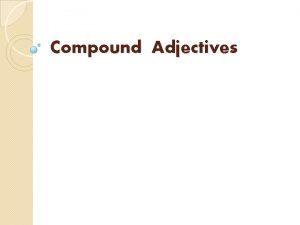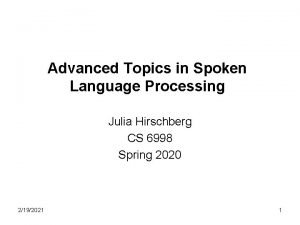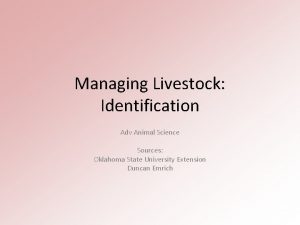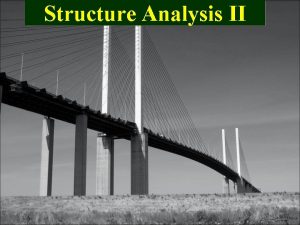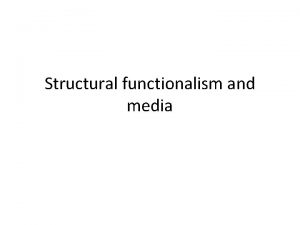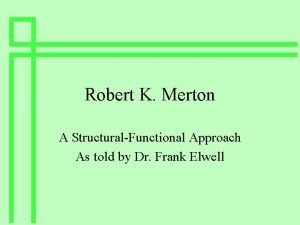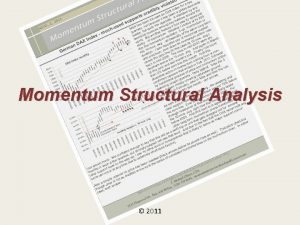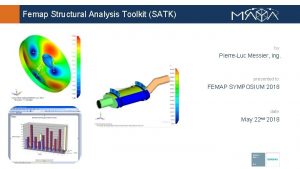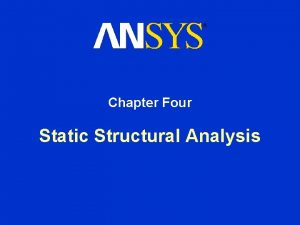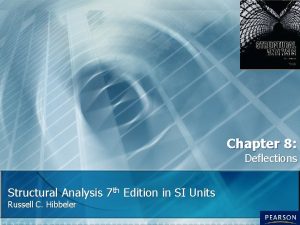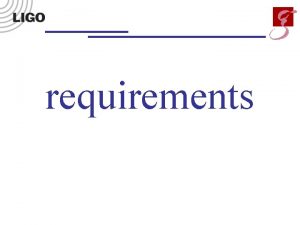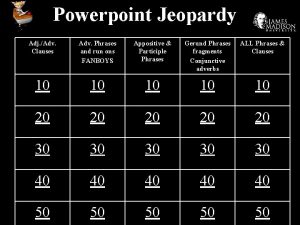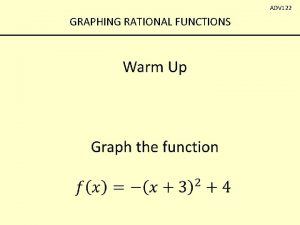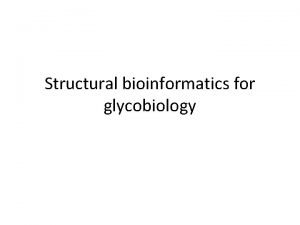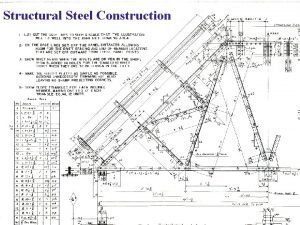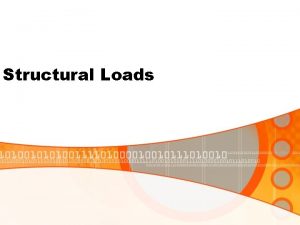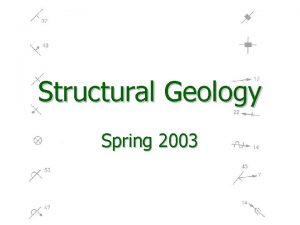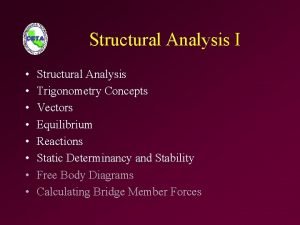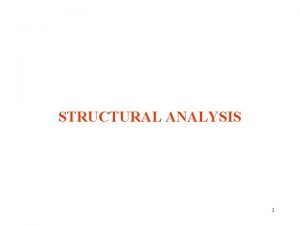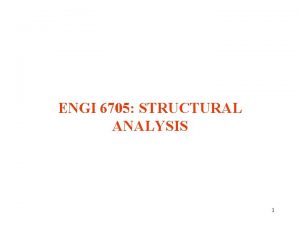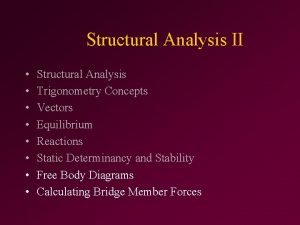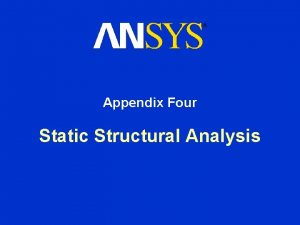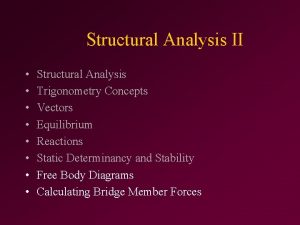Structural Analysis 1 Adv Higher Unit 3 Topic



















- Slides: 19

Structural Analysis 1 Adv Higher Unit 3 Topic 4 Unit 3. 4 Structural Analysis 1

Introduction This topic explores various methods used in the Structural Analysis of organic molecules starting with Elemental Analysis and Mass Spectrometry Unit 3. 4 Structural Analysis 2

Elemental Analysis 1 Empirical formulas are determined by combustion analysis: analysis Carbon, Carbon Hydrogen, Hydrogen Sulphur & Nitrogen can all be determined by combustion analysis Other elements can be determined by other methods. KHS Chemistry Unit 3. 4 Structural Analysis 3

Elemental Analysis 2 Calculation is same as taught at Standard Grade. KHS Chemistry Unit 3. 4 Structural Analysis 4

Empirical Formula 1 A substance was analysed and gave these results: C 47. 6% ; H 4. 76% ; N 22. 2% and O 25. 4% by mass. What is the empirical formula? In 100 g there will be 47. 6 / 12 moles of C = 3. 97 4. 76 / 1 moles of H = 4. 76 22. 2 / 14 moles of N = 1. 59 25. 4 / 16 moles of O = 1. 59 KHS Chemistry Unit 3. 4 Structural Analysis 5

Empirical Formula 2 Ratio of C: H: N: O is 3. 97: 4. 76: 1. 59 Divide by smallest number to simplify Simplifying ratio: 2. 5: 2. 99: 1: 1 Whole number ratio is 5: 6: 2: 2 Empirical formula is C 5 H 6 N 2 O 2 KHS Chemistry Unit 3. 4 Structural Analysis 6

Mass Spectrometry A mass spectrometer does three things ¬ vaporises a minute sample of compound (10 -10 g) ionises the vaporised molecules ® separates and analyses the ions, produced when the molecules fall apart, apart according to their mass/charge ratio, giving a mass spectrum KHS Chemistry Unit 3. 4 Structural Analysis 7

Mass Spectrometer KHS Chemistry Unit 3. 4 Structural Analysis 8

Molecular Ion A high-energy electron can dislodge an electron from a bond, creating a radical cation (a positive ion with an unpaired e-). Molecular ion M M+ . m 1+ 2 . m +m + 1 KHS Chemistry . +m m 1+ + m 2 2 Fragmentation then occurs. Unit 3. 4 Structural Analysis 9

Common Fragments Some fragments are more stable and, therefore, more likely Fragment m or m/z H 2 O 18 CH 3+ 15 CH 3 CH 2+ 29 CH 3 CO+ 43 C 7 H 7+ KHS Chemistry + Unit 3. 4 Structural Analysis 91 10

Tropylium Ion C 7 H 7+ + 91 This ion is a particularly stable ion and is often the most abundant peak (Base Peak). Peak Its presence indicates that the original molecule contained a benzene ring with a carbon attached - often a very useful aid to the identification of the overall molecule. KHS Chemistry Unit 3. 4 Structural Analysis 11

The Mass Spectrum Masses are graphed or tabulated according to their relative abundance. KHS Chemistry Unit 3. 4 Structural Analysis 12

Example 1 a rel abundance 100 CH 3 80 60 H 3 C 40 CH CH 2 CH 3 2 -METHYLPENTANE 20 20 KHS Chemistry 40 60 80 100 Unit 3. 4 Structural Analysis m/z 13

Example 1 b M+ rel abundance 100 80 . CH 3 60 H 3 C 40 CH CH 2 CH 3 86 20 20 40 60 80 100 m/z The main use of a mass spectrum (at Advanced Higher ) is to identify the Molecular ion KHS Chemistry Unit 3. 4 Structural Analysis 14

Example 1 c rel abundance 100 CH 3+ 80 CH 3 60 71 40 20 C 5 H 11+ H 3 C CH CH 2 CH 3 15 20 40 60 80 100 m/z Occasionally you can be asked to identify possible fragments KHS Chemistry Unit 3. 4 Structural Analysis 15

Example 1 d rel abundance 100 C 4 H 9+ 80 60 40 CH 3 27 29 20 20 C 2 H 5+ H 3 C 57 40 60 80 100 CH m/z CH 2 CH 3 C 2 H 3+ CH CH 2 Unstable fragments will often rearrange themselves to form more stable molecules. KHS Chemistry Unit 3. 4 Structural Analysis 16

Example 1 e The detailed analysis of a mass spectrum is best left to experienced operators with years of experience. KHS Chemistry Unit 3. 4 Structural Analysis 17

Use of Mass Spectra At Advanced Higher, the main (only? ) use of mass spectra is to determine the molecular formula of the molecule. M+ rel abundance 100 80 . CH 3 60 H 3 C 40 CH CH 2 CH 3 86 20 20 40 60 80 100 m/z IR Spectroscopy and NMR Spectroscopy will be used to identify the actual structure of the molecule. Unit 3. 4 Structural Analysis 18

High Resolution Mass Spectrometer Some modern Mass Spectrometers can now determine masses to 5 or 6 decimal places. This is accurate enough to differentiate between molecules of the ‘same mass’ Eg molecules with a mass of ‘ 44’ could be: C 3 H 8 C 2 H 4 O CO 2 or CN 2 H 4 A more accurate measurement of mass from the spectrometer could be 44. 029 C 3 H 8 C 2 H 4 O CO 2 CN 2 H 4 44. 06260 44. 02620 43. 98983 44. 03740 Unit 3. 4 Structural Analysis 19
 Voucher adv
Voucher adv Vinod sampat
Vinod sampat Adjectives for dinner
Adjectives for dinner Adv spoken language processing
Adv spoken language processing Adv report
Adv report Daily adv
Daily adv Noun adj adv
Noun adj adv Adv animal science
Adv animal science Med adv rppo
Med adv rppo Paragraph writing strategy
Paragraph writing strategy Narrowed down topic
Narrowed down topic Unit 10, unit 10 review tests, unit 10 general test
Unit 10, unit 10 review tests, unit 10 general test Structural unit of personality is
Structural unit of personality is Energy method in structural analysis
Energy method in structural analysis Structural functional analysis is given by
Structural functional analysis is given by Merton
Merton Oliver msa
Oliver msa Satk mark
Satk mark Static structural analysis in ansys workbench
Static structural analysis in ansys workbench Structural analysis chapter 8 solutions
Structural analysis chapter 8 solutions


